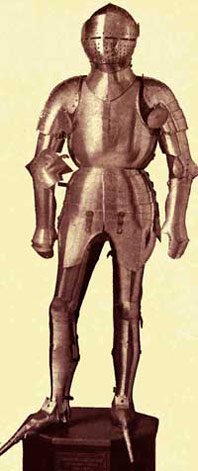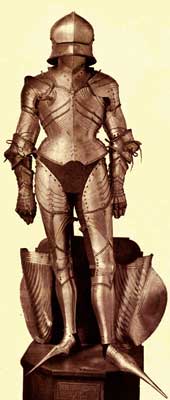Plate Armor - Development and Innovations
The period of plate armor can be delimited only arbitrarily, as there was also a transition period, when medieval armor was constructed of chain mail combined with plates. Roughly, the beginning of the 15th century, around 1410, is a good starting point.

Plate Armor of Friedrich Des Siegreichen, 1460
The construction of plate armor allowed for the protection of areas previously vulnerable to blow. The exposed mail under the armpit was one of these areas, known by the French name of “défaut de la cuirasse”. With the new type of armor, small plates of steel, named gussets, protected the armpit, and an impression of invulnerability was achieved.
However, war encounters and tournaments demonstrated that, at any period in the evolution of medieval armor, a fair blow, delivered by a well trained knight, using a well steeled lance, could penetrate every defence. Even more, no armor could be made proof against blows delivered downright with the two-handed battle axe used by an expert mounted knight.
With the disappearance of the jupon, the armor was exposed to view. The breastplate was globular in form. Below the waist we see the taces or laminated strips of plate overlapping each other. In the early period of plate, they were attached to a leather lining. Later, they were held together by sliding rivets, which allowed a certain amount of vertical play.
Generally, a full plate armor had the breast and back plates each of one piece, and the gorget usually in one. The limb-defences were of few pieces and rigid, except at the joints, which were guarded by caps or roundels. The armor of fingers, toes, and upper surfaces of the shoulders was articulated or protected by narrow laminar plates.
The introduction of the gussets, and of the horizontal bands of plate (tassets) forming the short petticoat below the waist, are the main distinctive features of 15th century plate armor. As flexibility was the main concern, the design modifications led to an increased number of articulations in every part of the armor, in many cases the limbs being protected by laminated plates. Fan-shaped elbow guards were also developed.
By 1440, great shoulder and elbow plates, attached by screws and nuts, concealed the articulated shoulder pieces or epaulettes. The shoulder plates could be bigger on the left side, the one supposed to receive the blow, giving to the armor an asymmetrical appearance. About 1445, the breast plate was articulated in two pieces, the lower overlapping the upper, and made flexible by using straps.
In the 15th century, the master armourers began to appreciate the intrinsic beauty of the steel, and graceful lines were introduced in the construction of plate armor. This artistic tendency is best exemplified by the “Gothic” style of armor. Appearing about the year 1440, it is a very distinct style, and the pieces executed during this period combine picturesque outlines with graceful fan or shell-like ridgings.
The cuirass was generally made of two pieces, for freedom of movement. From the taces are hung tassets, ending in a point towards the lower edge. The later form of Gothic breast plate was longer, with fewer taces.
Characteristic of Gothic plate armor are the sweeping lines embossed on its surfaces.


